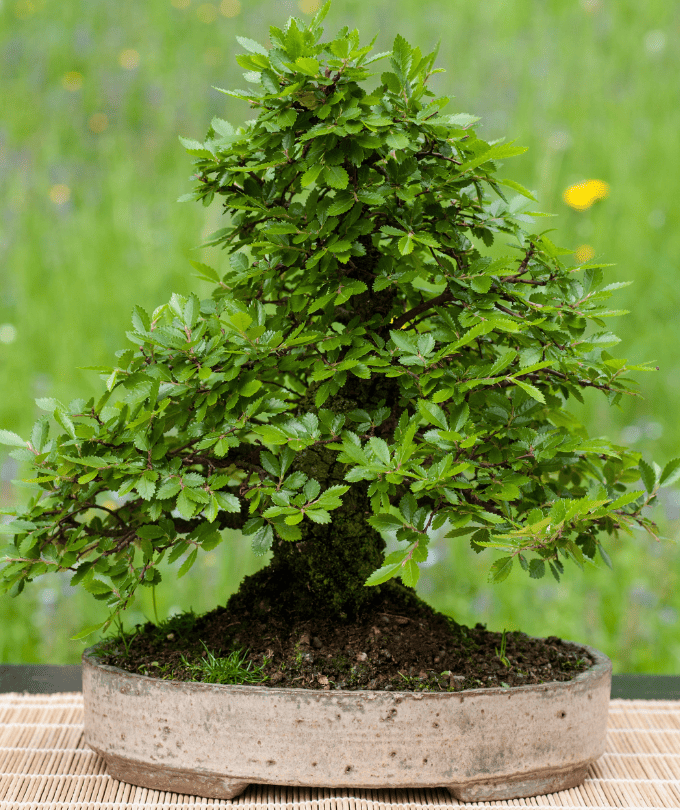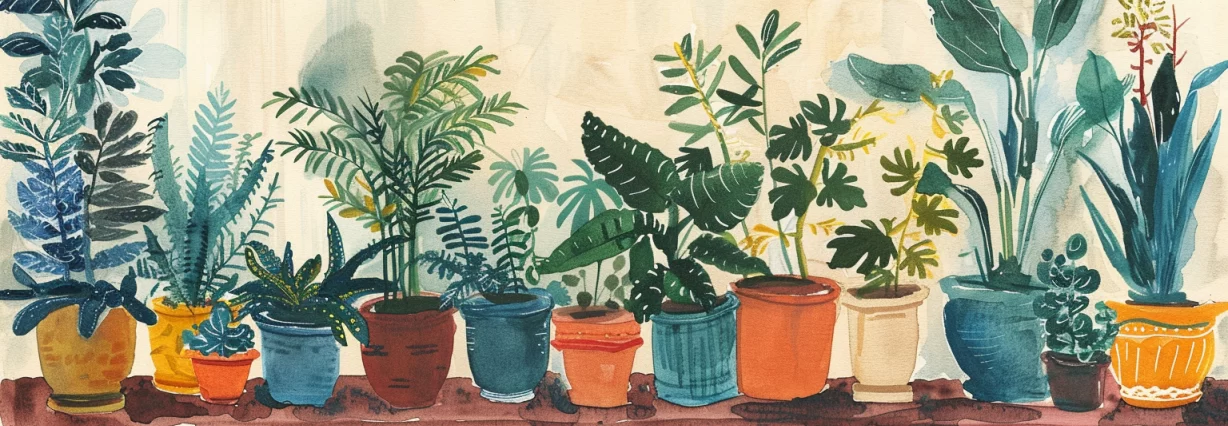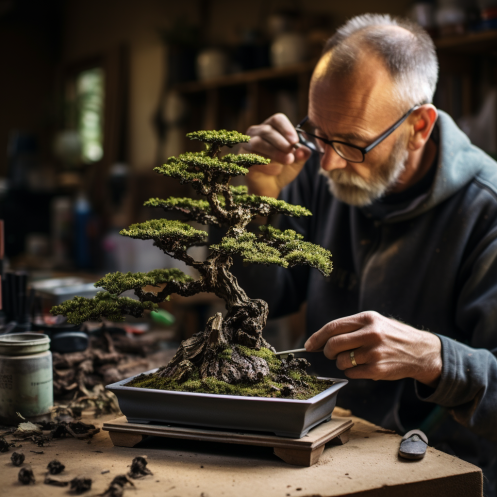Bonsai trees are miniature trees that require a specific set of care techniques to thrive. They are grown in small containers and require regular pruning, watering, and fertilization. While bonsai trees are delicate, they can be a rewarding hobby for beginners who are willing to put in the effort to care for them properly.
To start caring for a bonsai tree, beginners should first choose a suitable variety of bonsai tree based on their climate and indoor/outdoor growing conditions. Once they have chosen a tree, they should learn about the specific care requirements for that variety. This includes understanding the ideal soil composition, watering schedule, and pruning techniques.
With the right care techniques, bonsai trees can live for decades and become a beautiful addition to any home or garden. This article will provide beginners with essential bonsai care techniques to help them get started on their bonsai journey.

Understanding Bonsai
Bonsai is a Japanese art form that involves growing miniature trees in small containers. It is a practice that has been around for centuries and has gained popularity all over the world.
History and Significance
The art of bonsai originated in China over a thousand years ago and was later adopted by the Japanese. The word “bonsai” is derived from the Japanese word “bon” meaning tray and “sai” meaning plant. Bonsai trees were initially grown for religious and spiritual purposes, but it later became a form of art.
Bonsai trees are significant because they represent the beauty of nature in a small and controlled environment. They also symbolize the balance between nature and humans. Bonsai trees require patience, dedication, and skill to grow and maintain, making them a symbol of discipline and perseverance.
Types of Bonsai Trees
There are two main types of bonsai trees: indoor and outdoor. Indoor bonsai trees are typically tropical or subtropical trees that are grown indoors. On the other hand, outdoor bonsai trees are typically hardy trees that can withstand cold temperatures and are grown outdoors.
Many different species of trees can be grown as bonsai trees, including maple, juniper, pine, and cherry blossom. Each species has its unique requirements for growth and care. It is essential to research the specific needs of the species you want to grow before starting your bonsai journey.
In conclusion, understanding the history and significance of bonsai and the different types of bonsai trees is essential for any beginner who wants to grow and maintain a healthy bonsai tree.
Getting Started
Bonsai, the art of growing miniature trees in pots, can be a rewarding hobby for beginners. However, it requires patience, dedication, and proper care techniques. This section will cover the essential steps to get started with bonsai care.
Selecting Your Bonsai
For beginners venturing into the captivating world of bonsai, the choice of the right tree is a fundamental decision that can significantly influence the success and enjoyment of the bonsai journey. Starting with a species that is hardy and easy to care for is highly recommended, providing a forgiving entry point for those new to the art of bonsai cultivation.
Popular choices for novice bonsai enthusiasts include species such as Ficus, Juniper, and Chinese Elm. These trees are known for their resilience and adaptability, making them well-suited for beginners. Their hardiness allows for a certain level of forgiveness, offering room for learning and experimentation without the risk of overly sensitive or delicate species that may require more advanced care techniques.
The accessibility of these beginner-friendly species is another advantage. Ficus, Juniper, and Chinese Elm bonsai trees are commonly available at nurseries and online stores dedicated to bonsai supplies. This availability ensures that beginners can easily find suitable specimens to start their bonsai journey.



Moreover, the versatility of these species makes them suitable for a range of environments. Whether cultivating bonsai indoors or outdoors, these trees can thrive with proper care. This flexibility provides beginners with the option to choose a setting that aligns with their living situation and preferences, whether it be a small apartment balcony or a dedicated outdoor garden space.
In essence, the choice of a hardy and easy-to-care-for bonsai species sets the stage for a positive and rewarding experience for beginners. It allows them to focus on foundational aspects of bonsai care, such as watering, pruning, and shaping, without the added challenges associated with more delicate or demanding species. As beginners build their confidence and skills, they can then explore a broader range of bonsai species and techniques, expanding their appreciation for this ancient and artful horticultural practice.
When selecting a bonsai tree, consider its size, shape, and style. Bonsai trees come in various shapes and styles, such as formal upright, informal upright, slanting, cascading, and semi-cascade. Choose a style that appeals to you and fits your skill level.
Essential Tools and Supplies
To care for your bonsai tree, you will need a few essential tools and supplies. These include:
- Bonsai soil: a well-draining soil mix specifically designed for bonsai trees.
- Bonsai pot: a shallow pot with drainage holes that fits the size of your bonsai tree.
- Pruning shears: a sharp pair of scissors or clippers for trimming branches and leaves.
- Bonsai wire: a flexible wire for shaping and training branches.
- Watering can or spray bottle: for watering your bonsai tree.
- Fertilizer: a balanced fertilizer specifically formulated for bonsai trees.

It is important to use high-quality tools and supplies to ensure the health and longevity of your bonsai tree. Invest in good-quality tools and follow the care instructions carefully.
By following these essential steps, beginners can get started with bonsai care and enjoy the beauty and tranquility of miniature trees in their homes or gardens.
Bonsai Basics
Bonsai is a Japanese art form that involves growing small trees in containers. It is a unique and rewarding hobby that requires patience and dedication. For beginners, it is important to understand the basics of bonsai care to ensure the health and longevity of the tree.
Potting and Soil
Choosing the right pot and soil is essential for the health of your bonsai tree. The pot should have good drainage and be the appropriate size for the tree. The soil should be well-draining and nutrient-rich, as bonsai trees require a lot of nutrients to grow properly. A mixture of akadama, pumice, and lava rock is popular for bonsai soil.
Watering Techniques
Watering your bonsai correctly is crucial for its survival. Overwatering can lead to root rot, while underwatering can cause the tree to dry out and die. The watering frequency depends on the tree type, the pot size, and the climate. As a general rule, the soil should be kept moist but not waterlogged. It is also important to thoroughly water the tree, ensuring it reaches all parts of the soil.
Sunlight and Placement
Bonsai trees require a lot of sunlight to grow properly. They should be placed in a location that receives at least 6 hours of direct sunlight daily. However, protecting the tree from extreme heat and cold is important, as this can damage the leaves and branches. If the tree is kept indoors, it should be placed near a window that receives plenty of sunlight.
In conclusion, understanding the basics of bonsai care is essential for beginners. By choosing the right pot and soil, watering the tree correctly, and placing it in a location that receives plenty of sunlight, you can ensure the health and longevity of your bonsai tree.
Maintenance and Care
Pruning and Trimming
Pruning and trimming are essential bonsai care techniques that help maintain the shape and size of the bonsai tree. It also promotes new growth and a better branch structure. Pruning involves removing branches and leaves while trimming involves cutting back shoots and buds. When pruning and trimming, it’s important to use the right tools, such as sharp scissors, pruning shears, and wire cutters. It’s also important to prune and trim at the right time, which varies depending on the bonsai tree species.

Repotting and Root Care
Another important bonsai care technique is repotting and root care, which helps ensure the health and growth of the tree. Repotting involves removing the tree from its current pot, trimming the roots, and repotting it in fresh soil. This should be done every 2-3 years, depending on the tree’s growth rate. When repotting, it’s important to choose the right soil mix, which varies depending on the bonsai tree species. Root care also involves regular watering and fertilization to ensure the roots are healthy and strong.
Fertilizing Fundamentals
Fertilizing is essential for the growth and health of the bonsai tree. It provides the necessary nutrients for the tree to thrive. When fertilizing, it’s important to use the right type of fertilizer, which varies depending on the bonsai tree species. It’s also important to fertilize at the right time, which varies depending on the type of fertilizer used. Over-fertilizing can be harmful to the tree, so it’s important to follow the recommended guidelines for fertilization.
Overall, proper maintenance and care are essential for the health and growth of a bonsai tree. By following these essential bonsai care techniques, beginners can ensure their bonsai tree thrives for years to come.
Advanced Techniques
Bonsai trees are not just beautiful to look at, but they also require careful maintenance to keep them healthy and aesthetically pleasing. Advanced techniques such as wiring and shaping, and creating deadwood can help create a more intricate and visually stunning bonsai.
Wiring and Shaping
Wiring and shaping are two important techniques that can be used to create a particular style or shape of a bonsai tree. Wiring can be used to bend the branches of the tree into a specific shape while shaping can be used to create a particular style of the tree.
When wiring a bonsai tree, it is important to use the right type of wire and gently wrap it around the branch. The wire should be wrapped around the branch in a spiral motion, starting from the base and working towards the tip. Once the wire is in place, the branch can be gently bent into the desired shape.

Shaping a bonsai tree involves pruning the branches and leaves to create a specific style. Different bonsai styles include formal upright, informal upright, slanting, semi-cascade, and cascade. Each style requires a different approach to pruning, and it is important to research each style thoroughly before attempting to shape a tree.
Creating Deadwood
Creating deadwood is another advanced technique that can be used to create a more intricate and visually stunning bonsai. Deadwood refers to the parts of the tree that have died, such as the bark and the wood.
Creating deadwood involves removing the bark from certain parts of the tree to create a more rugged and aged appearance. This technique is often used in bonsai styles such as literati and windswept.
To create deadwood, a sharp knife or chisel is used to carefully remove the bark from the tree. The exposed wood can then be treated with lime sulfur to create a more natural and aged appearance.

Overall, advanced techniques such as wiring and shaping, and creating deadwood can help create a more intricate and visually stunning bonsai. However, it is important to research each technique thoroughly before attempting it and to use the right tools and materials to avoid damaging the tree.
Pest and Disease Management
Bonsai trees, like any other plant, are susceptible to pests and diseases. However, these issues can be easily managed with proper care and attention. Here are some essential tips for pest and disease management for beginners:
Identify the Problem
The first step to managing any pest or disease problem is accurately identifying the issue. Common pests that affect bonsai trees include aphids, spider mites, mealybugs, and scale insects. Diseases such as powdery mildew, root rot, and leaf spot can also affect bonsai trees. By identifying the problem, you can choose the appropriate treatment method.
Prevention is Key
Preventing pest and disease problems is always better than trying to treat them. Good bonsai care practices such as proper watering, fertilization, and pruning can help prevent these issues. Keeping your bonsai tree in a healthy and stress-free environment can also help prevent pest and disease problems.
Treatment Options
Several treatment options are available if your bonsai tree develops a pest or disease problem. Some common treatments include:
- Insecticidal soap: This is a gentle and effective treatment for many common pests, such as aphids and spider mites.
- Neem oil: This is a natural insecticide that can be used to treat a variety of pests.
- Fungicide: This can be used to treat fungal diseases such as powdery mildew.
It is important to follow the treatment product instructions carefully and apply it at the appropriate time. Some treatments may need to be repeated several times to be effective.
By following these essential pest and disease management tips, beginners can keep their bonsai trees healthy and thriving.
Seasonal Care
Bonsai trees require different care depending on the season. Here are some tips for taking care of your bonsai tree throughout the year.
Spring Care

Spring emerges as a prime season for pruning, as the tree enters an active growth phase. During this time, the bonsai tree’s metabolism accelerates, and its energy is directed towards producing new shoots and leaves. Pruning in spring takes advantage of this heightened growth activity, stimulating the tree to generate fresh, vibrant growth.
One of the primary objectives of spring pruning is the removal of dead or damaged branches. Clearing away these non-productive parts not only enhances the visual aesthetics of the bonsai but also encourages the allocation of resources towards healthier areas. Additionally, trimming back branches that have grown excessively long maintains the desired proportions of the tree, preventing it from becoming unbalanced or losing its defined shape.
Spring also marks an opportune time for repotting bonsai trees. Repotting is a vital practice that rejuvenates the tree’s root system and ensures the availability of essential nutrients. Performing repotting during the active growth phase in spring allows the bonsai to recover more swiftly from the stress of being uprooted and transplanted. The tree’s robust growth during this period aids in the rapid establishment of new roots and helps it adapt to its refreshed environment.
Conducting both pruning and repotting in spring creates a harmonious synergy in the care routine of the bonsai. Together, these practices promote the overall well-being of the tree, encouraging vigorous growth, maintaining aesthetic balance, and sustaining the health of both above-ground and below-ground components.
In summary, the timing of spring pruning and repotting aligns with the natural growth cycles of the bonsai tree, harnessing the energy and vitality it exhibits during this season. This thoughtful approach not only fosters a flourishing and visually appealing bonsai but also ensures the long-term resilience and vitality of this living work of art.
Summer Care

Shielding your bonsai tree from the intense summer sun is a critical aspect of its care, as prolonged exposure to direct sunlight can lead to stress and damage. During the summer months, it is advisable to position your bonsai in a shaded area where it can enjoy filtered sunlight or dappled shade. Alternatively, employing a shade cloth provides an effective means of diffusing and reducing the intensity of sunlight, offering protection without completely obstructing the light necessary for photosynthesis.
Direct sunlight, especially during the peak heat of the day, can cause the soil to dry out rapidly. To counteract this, it is essential to adjust the watering routine for your bonsai during the summer. The increased temperatures and heightened evaporation rates necessitate more frequent watering to maintain adequate moisture levels in the soil. Regularly check the soil’s moisture content, and water your bonsai as needed to prevent it from drying out. Consistent and thorough watering helps ensure that the tree remains hydrated, promoting healthy growth and preventing stress-induced issues.
Furthermore, when watering your bonsai during the summer, it is advisable to do so in the morning or late afternoon to avoid subjecting the tree to the most intense sunlight and heat. Watering during these times allows the moisture to be absorbed by the soil before the sun reaches its zenith, reducing the risk of water droplets acting as magnifying lenses and potentially causing burns on the leaves.
In essence, protecting your bonsai from the hot summer sun involves a combination of strategic placement and attentive watering practices. By providing a shaded environment and adjusting the watering frequency to meet the tree’s increased needs, you not only shield your bonsai from potential harm but also create optimal conditions for its well-being and continued vitality throughout the summer season.
Autumn Care

Transitioning your bonsai tree care routine in autumn is crucial, aligning with the natural changes the tree undergoes as it prepares for dormancy. During this season, it’s essential to adjust both the watering and fertilizing practices to support the tree’s shifting metabolic processes.
As autumn heralds the onset of dormancy, it is advisable to reduce the amount of water provided to your bonsai. The tree’s metabolic activity slows down, and its water requirements diminish. Excessive moisture in the soil during this period can lead to a heightened risk of root rot, a condition caused by fungal pathogens that thrive in overly damp conditions. By moderating the watering regimen and allowing the soil to dry out slightly between watering sessions, you create an environment that discourages the development of root rot and promotes the health of the bonsai’s root system during the dormant phase.
Concurrently, autumn is an opportune time to apply fertilizer to your bonsai tree. As the tree transitions into dormancy, it begins to allocate resources towards storing nutrients. Fertilizing in autumn supplements the tree with essential elements that it will draw upon during the winter months when active growth is minimal. This strategic nutrient application ensures that the bonsai has the necessary reserves to support its metabolic functions and encourages robust growth when the growing season resumes in spring.
Choosing a balanced and slow-release fertilizer specifically formulated for bonsai trees is ideal. This type of fertilizer provides a steady supply of nutrients over an extended period, aligning with the gradual nutrient uptake typical of the bonsai’s natural growth patterns.
In summary, adjusting your bonsai care routine in autumn involves a delicate balance between reducing water to prevent root rot and providing a timely dose of fertilizer to support the tree’s nutrient storage for the upcoming winter dormancy. By attuning your care practices to the changing needs of the bonsai, you contribute to its overall resilience and vitality throughout the seasonal cycles.
Winter Care

Winter poses unique challenges for bonsai care, and protecting your tree during this season is essential to ensure its survival and health. One of the primary concerns during winter is freezing temperatures, which can be detrimental to the well-being of bonsai trees, especially those that are not cold-hardy. To shield your bonsai from freezing conditions, consider relocating it to a sheltered area, such as a garage or shed, where it can be protected from extreme cold and harsh winds. Alternatively, covering the bonsai with a frost blanket provides an additional layer of insulation, helping to safeguard it from frostbite and dehydration.
Another crucial adjustment in winter bonsai care involves moderating the watering routine. Since bonsai trees are not actively growing during the winter months, their water requirements diminish significantly. Overwatering during this period can lead to soil saturation, potentially causing root rot as the tree’s metabolic processes are minimal. By reducing the amount of water you provide, allowing the soil to dry out more between waterings, you help prevent waterlogged conditions and promote a healthier root system.
It’s important to note that while reducing watering is essential, completely withholding water is not advisable. Even in winter, bonsai trees require some moisture to prevent dehydration and maintain overall vitality. Regularly check the moisture levels in the soil and adjust your watering schedule accordingly, ensuring a balance between avoiding waterlogged conditions and preventing the bonsai from drying out.
Winter care for bonsai involves a delicate equilibrium between protecting the tree from freezing temperatures and adjusting watering practices to reflect its dormant state. By providing the right environment and minimizing water to match the tree’s reduced metabolic activity, you contribute to the resilience of your bonsai, ensuring it emerges from the winter dormancy with vigor and readiness for the upcoming growing season.


